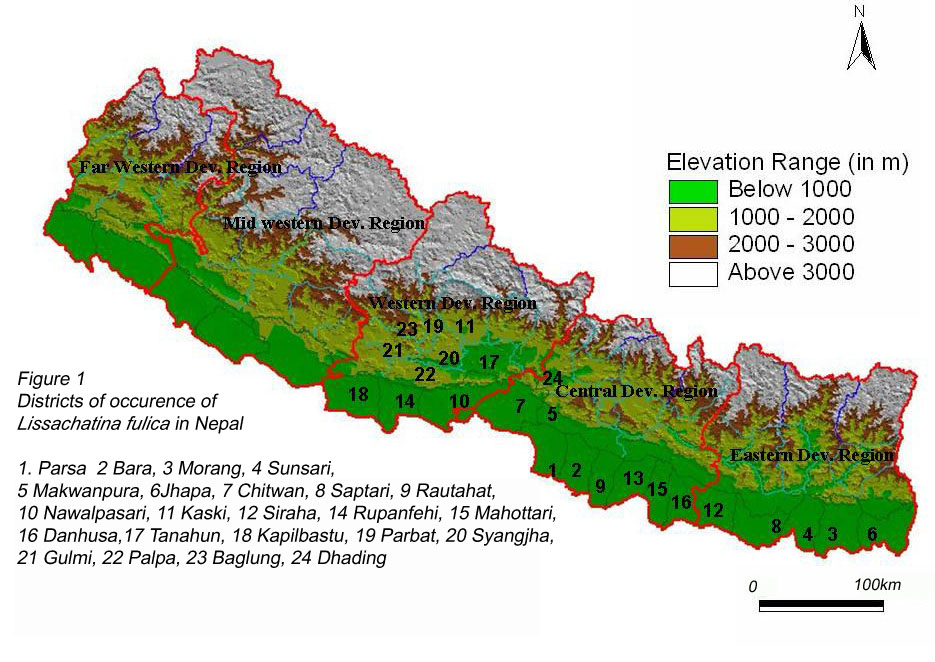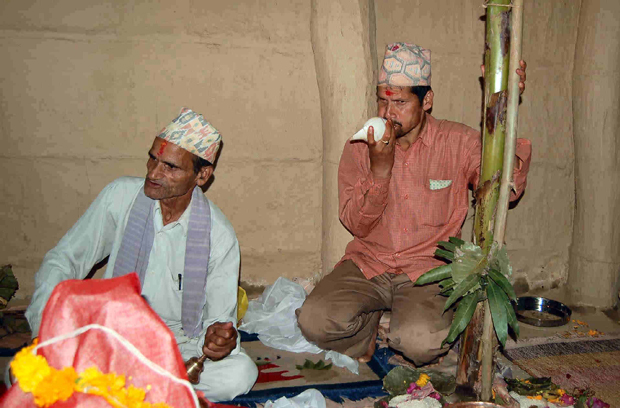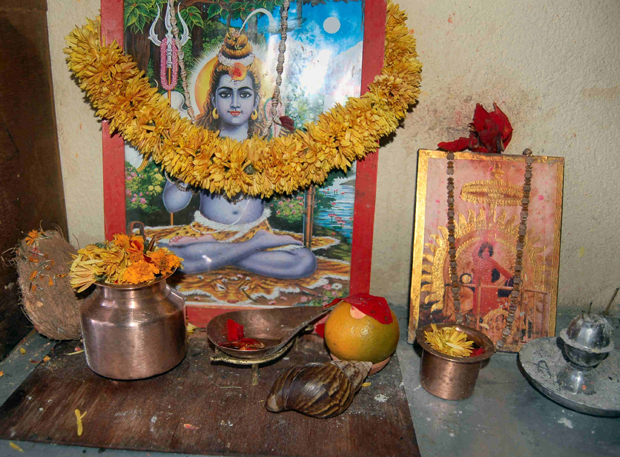

The Giant African Land Snail Lissachatina fulica (Bowdich) in Nepal
Prem B. Budha1 and Fred, Naggs2
1 Centre
for Biological Conservation Nepal P.O. Box 1935, Kathmandu Nepal,
E-mail- prem...@yahoo.com
2 Natural
History Museum, Cromwell Road, London, UK
The Giant African Land
Snail Lissachatina fulica (Bowdich,1822) is among the world’s
most damaging 100 invasive alien species (Lowe et al., 2000). Having
originated in east Africa it has now spread throughout much of the
tropics by human agency and, with such a wide distribution and often
high densities, this large pest species is likely to have the greatest
global biomass of any land snail. Current genetic studies indicate
that all L. fulica now occurring throughout South Asia,
Southeast Asia and the Pacific Region are derived from one haplotype
(Fontinilla et al., 2007); the source being a single pair
of specimens released in a Calcutta garden in Chowringhee in 1847
(Naggs, 1997). The myth that these were released by the pioneering
malacologist William Henry Benson was erroneously perpetuated by
Mead (1961). Although Benson had taken L. fulica to India
from Mauritius, probably from the garden of his old school friend
Sir David Barclay, he had handed them to a friend and neighbour
before leaving India and it was the friend who released them in
his garden (Naggs, 1997). Subsequently Benson noted (1858) that
L. fulica had become well-established and although the
initial spread was slow (Blanford, 1868; Godwin-Austen, 1908) its
range gradually extended through much of the Indian subcontinent.
By the mid-twentieth century its range in India was still supposedly
confined to Bengal (Mead, 1979), but it seems likely that the spread
was far more extensive by that time.
L. fulica was probably introduced into Nepal from adjacent
areas of India. It is now well established but there is no record
of when it first arrived and its present range and status within
Nepal are poorly known. Raut (1999) found abundant populations of
L. fulica in Nepal’s eastern urban areas: Biratnagar,
Jaleshwor, and Birgunj, with possible indication of its establishment
60-70 years ago. Our study indicates that it first entered the southern
part of Nepal in the east. It then spread to western limits of the
Western Development Region of the Terai and extended north across
the Siwalik Hills to Makwanpur, Chitwan and Tanahun. It has crossed
the Mid Hill range and ascended the lower slopes of the Mahabharat
Range at Baglung, Parbat, Arghakhanchi, Gulmi, Dhading, Kaski and
Syangjha. However, the higher elevations are undoubtedly too cold
in winter for it to survive and L. fulica has not crossed
into the Kathmandu Valley. An attempt was made in 1998 to raise
ten individuals of L. fulica in Kathmandu but none survived
the winter (previously unpublished investigation by Prem Budha).
With the daily transfer of agricultural produce into Kathmandu many
individuals and eggs will undoubtedly have been transported there
but with winter temperatures going down to 00 to -20C
in the Kathmandu Valley it is apparently too cold for it to become
established.

A questionnaire survey and field observations from 5-17th September,
2006 recorded the presence of L. fulica in many hill districts
of the Development Region (Arghakhanchi, Baglung, Gulmi, Kaski,
Parbat and Suangjha). In the Tarai it was recorded from Kapilbastu,
Rupandehi, Nawalparasi, Chitwan, Makwanpur, Parsa, Bara, Rautahat,
Sarlahi, Mahottari, Dhanusha, Siraha, Saptari, Sunsari, Morang and
Jhapa districts. The most recent range extensions appear to be in
Baglung and Parbat districts (Fig. 1). In Syangjha, Baglung and
Parbat respondents stated that it was introduced from Pokhara during
the construction phase of the Kaligandaki-A hydropower project and
the Pokhara-Baglung highway construction. The rate of spread can
be very rapid and some people, regarding it as a Chank shell Turbinella
pyrum (L, 1758) (Fig. 2), an important Hindu religious symbol
of worship, unwittingly carry it to their homes. Specimens subsequently
released into traditional home gardens rapidly become major pests,
feeding on garden produce.

Figure 2
The Present Status
of L. fulica
Population Status
Discussions with local people in the areas visited, the questionnaire
survey and direct observation have revealed that the establishment
of L. fulica has followed urbanization along the east-west
and north-south highways in the mountains of Western Nepal from
where it spreads to rural villages. High densities were reported
in Beltari, Kushma, Pokhara, Damauli and Bharatpur in the districts
of Syangja, Parbat, Kaski, Tanahun and Chitwan respectively. The
abundance and range in other areas of eastern Terai has yet to be
assessed. The highest population densities were observed in refuse
disposal sites, home gardens, around old rough walled buildings
and boundary walls.
Dispersal
Human agency is reported to be the main means of dispersal for L.
fulica. Collection and dispersal linked to religious belief
was often given as a mechanism for dispersal by respondents to our
questionnaire and during interviews. For example, the local leader
of Byans Municipality, Mr. Purushottam Kafle, was struck by the
beauty of the snail when he first encountered it. He thought it
was a personal gift from God. He venerated and worshipped the snail
in his house and fed it with cow’s milk for several days in
1968. Another example is a woman of the Rai community who was walking
with us in Phoksing, Parbat. On showing her an example, she told
us that she kept a shell in the Pooja room of her house, an area
set aside for daily worship (fig. 3, centre foreground). It seems
that, on first encountering L. fulica, many rural people
treasure it as a revered living example of the sea chank shell that
is blown during religious ceremonies. A respondent at Mirmi informed
us that she had seen two people carrying a polythene sack full of
live adults to release in their home garden. In response to growing
awareness of the pest status of L. fulica a local businessman
in Harmichaur stopped school children from carrying live snails
home by informing them of its pestiferous nature. However, direct
carriage of snails into new areas remains a major problem and we
were told of Mr Keshav Neupane bringing a pair of L. fulica
from Pokhara and releasing them in Mirmi and Beltari, Syangjha district
during the construction phase of Kaligandaki-A Hydropower Project
in 1997/98. The wonderment and delight on initial discovery is rapidly
transformed to fear and alarm when people are faced with the damage
caused in their fields and gardens. There are of course many modes
of dispersal by human agency that do not involve deliberate acts
such as spreading through fodder collection, transport of water
pipes and along irrigation canals. In Damauli L. fulica
was considered to have been introduced through water pipes either
from Birgunj or from Chitwan. It was also clear that many individuals
troubled by the damage they caused intentionally throw snails away
in areas where they did not previously occur.
Figure 3
Damage
The Giant African Snail is a serious pest of vegetables and considered
to be a major problem in kitchen home gardens by District Agriculture
Officers in many districts where they occur. Many farmers have complained
that they could not grow nursery-raised vegetables by transplanting
them into the fields because they are immediately eaten by L.
fulica. They can completely wipe out vegetable crops such as
cauliflower, potato, cabbage, pumpkin, cucumber, bottle gourd, white
gourd, spinach, radish and tomato. Cereals such as hyacinth bean,
cow pea, black gram, maize and millet, and fruits such as banana,
guava, papaya, and jack fruit are all considered to be vulnerable.
One of the respondents in Mirmi told us that one day before our
visit 500 recently transplanted cauliflower and cabbage plants were
completely destroyed within just one night.
Health Hazard
and Nuisance
The snails produce numerous eggs, grow very rapidly and are abundant
on foot trails; several respondents complained of the wounds made
by the snail’s sharp broken shells. They leave sticky slime
trails and excreta wherever they wander such as on vegetable leaves
and walls of houses; in addition to being unpleasant and unsightly
these are potential sources of infection. One common and widespread
practice is to throw snails onto roads in the hope that they will
be crushed by passing traffic. The density of rotting snails can
be such as to impart an offensive odour along extensive lengths
of road. In addition, many farmers who work in fields informed us
about a troublesome allergy and itching as a result of coming into
contact with the putrid water that collects in the shells of the
dead snails that litter the fields. Respondents from Beltari, Syangjha
district also informed us about a livestock sickness that leads
to a significant reduction in milk yields. The sickness immediately
followed the arrival of L. achatina and they attributed
the sickness to the presence of the snail. Such reports are firmly
believed but require further investigation to establish if there
really is a link.
Use as Food
L. fulica has recently been used by some fish farmers as
a diet especially for Clarias batrachus, a commercially
important species introduced from India. Some farmers were also
reported to feed snail flesh to pigs but we did not find direct
evidence of this. A commercial fish farmer on Bharatpohari Village
Development Committee told us that The Giant African Snail is the
best food for fish and fish favour it over other food. Local people
also informed us that they have observed living L. fulica
being eaten by crows, monitor lizards, the common mongoose, swans,
pigs and poultry, although some of these would presumably have been
juvenile snails.
Local Control
Measures
Only collection and killing of snails was reported as the local
control measure. Most people use salt to kill the snails by dehydration;
a popular method is to pack snails in plastic bags and throw them
onto roads to be crushed by passing traffic. People living by rivers
and irrigation canals throw their daily collections directly into
flowing water. The Byans Municipality of Tanahun district initiated
an official eradication program of L. fulica in 1993 with
the help of public participation by providing 20 Nepalese Rupees
per 10 kg incentive to local people. The municipality dumped more
than 5.5 metric tones of collected snails on the bank of the Madi
river. This practice was followed for a number of years but has
since been abandoned and L. fulica continues to be abundant
in the area.
Acknowledgements
The authors are grateful to the UK’s Department of Environment,
Food and Rural Affairs (Defra) for financial support through the
Darwin Initiative project: Developing land snail expertise in South
and Southeast Asia, and The Malacological Society of London for
a Research Grant to Prem Budha. We would like to thank Ramesh Devkota
and Naresh Kohar for helping in the field work, Dr. Dhananjaya Regmi
for producing the distribution map of L. fulica and Elizabeth
Platts for commenting on the manuscript.
References
| Benson, W.H. 1858. Note sur la transportation et la naturalization au Bengale de l' Achatina fulica | |
| de Lamarck. Journal de Conchyliologie. 1: 336-339. | |
| Blanford, W.T. 1868. On the occurrence of Diplommatina huttoni and Ennea bicolor in the | |
| West Indies. Annals and Magazine of Natural History. 1: 110-112 | |
| Fontanilla, I.K.C., Hudelot, C. Naggs, F. and Wade, C.M. 2007. Achatina fulica: its molecular | |
| phylogeny and genetic variation in global populations. Abstracts. World Congress of Malacology, Antwerp, Belgium 15-20 July, 2007. Page 63. | |
| Godwin-Austen, H.H.1908. Dispersal of land shells by the agency of man. Proceedings of | |
| Malacological Society of London. 8: 146-147. | |
| Lowe S.,Browne M., Boudjelas S., & De Poorter M. 2000. 100 of the World's Worst Invasive Alien | |
| Species: a selection from the Global Invasive Species Database. Published by The Invasive Species Specialist Group (ISSG) a specialist group of the Species Survival Commission (SSC) of the World Conservation Union (IUCN), 12pp. [First published as special lift-out in Aliens 12, December 2000]. Updated and reprinted version: November 2004. | |
| Mead, A.R. 1961. The Giant African snail: a problem in economic malacology. The University | |
| of Chicago Press, USA. | |
| Mead, A.R. 1979. Economic malacology with particular reference to Achatina fulica: In Pulmonates. | |
| Vol. 2B (V.Fretter & J.Peake, eds) pages 1-150. Academic Press, London. | |
| Naggs, F. 1997. William Benson and the early study of land snails in British India and Ceylon. | |
| Archives of Natural History. 24: 37-88. | |
| Raut, S.K. 1999. The Giant African land snail, Achatina fulica Bowdich in Nepal and Bhutan. | |
| Journal of the Bombay Natural History Society. 96: 73. | |